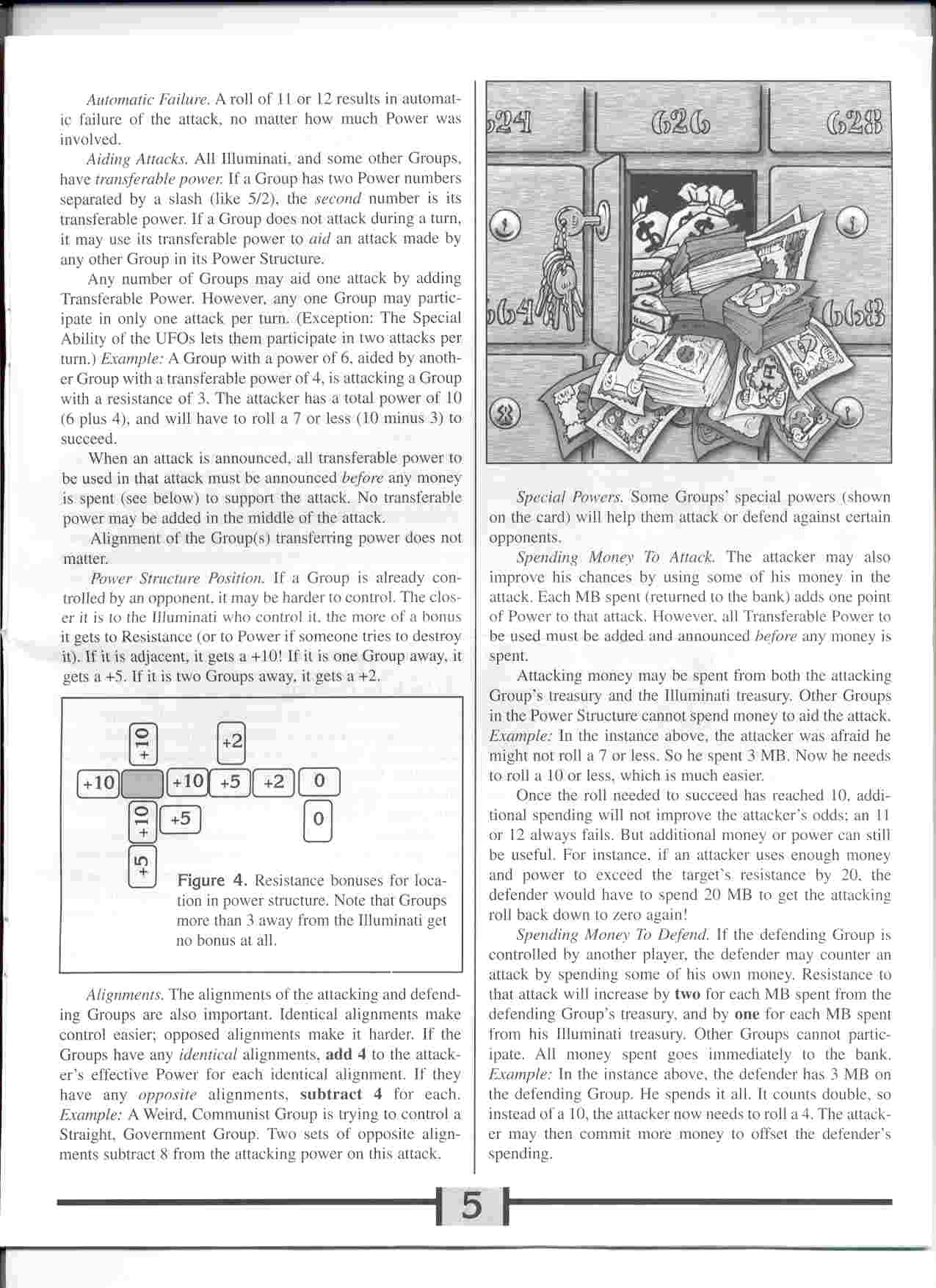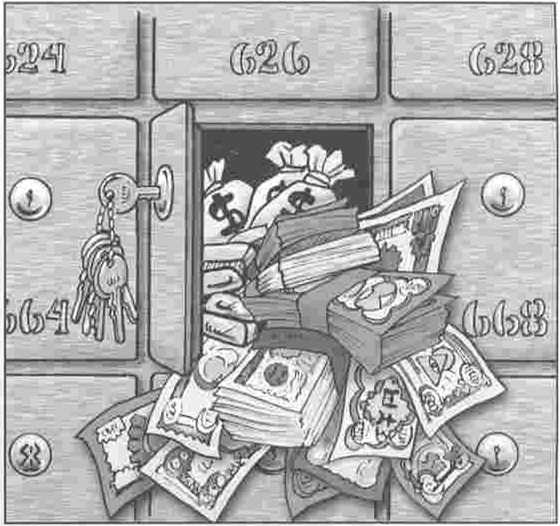rulespage5

Automatic Failure. A roli of 11 dr 12 rcsulls in automat-ic failure ot the attack. no matter how much Power was involved.
Auting Anacks. Ali llluminati. and some other Groups. have transferable power. If a Group lias two Power numbers separaled by a slash tlike 5/2), tlie ieconcl number is its iransferable power. If a Group does not attack du.ri.ng a turn, il may use its iransferable power to aid an attack madę by anv other Group in its Power Structure.
Any number of Groups may aid one attack by adding Transferable Power. Howeyer. any one Group may partic-ipate in only one attack per turn. (Exception: The Special Ability of the UFOs lets thein participate in iwo altacks per turn.) Example: A Group with a power of 6. aided by anoth-cr Group with a Iransferable power of 4, is attacking a Group with a resistan.ee of 5. The attacker has a total power of Id (6 plus 4). and will have to roli a 7 or less (10 minus 3) to sueceed.
Wlien an attack is announeed. all transferable power to be used in thal attack musi be announeed bcforc any money is spent (see helów) to suppórt the attack. No transferable power may be added in the middle uf the attack.
Alignrnent of the Group(s) transferring power does not matter.
Power Structure Positiou. If a Group is already contro! led by an opponent. il may be harder to control. The clos-er il is to the llluminati who control it. the morę of a bonus ii gets to Resistance tor to Power if someone tries to destroy il). If il is adjacent. it gets a + 10! If il is one Group away. u gets a +5. If it is iwo Groups away. it gets a +2.
|
o |
f+3 | |||
|
-2J | ||||
|
o r-» + |
0 | |||
|
tn | ||||
|
+ |
Figurę 4. Resistance bonuses for loca-tion in power structure. Notę that Groups morę tltan 3 away front the llluminati get | |||
|
no bonus at all. | ||||
Alignments. The alignments ot the attacking and defend-ing Groups aro also important. Idcntical alignments make control easier: opposed alignments make it harder. If the Groups have any idcntical alignments. add 4 to the attaek-er’s effectiye Power for each idcntical alignrnent. If they have any oppositc alignments, subtraet 4 for each. Exaniple: A Weird, Commuttist Group is tryjng to control a Straight. Government Group. Two sets of oppositc alignments subtraet X front the attacking power on this attack.

Special Powcrs. Some Groups' special powers (shown on the card) will help litem attack or defend against eerlain opponents.
Spending Money To Attack. The attacker may also improvc his chances by using some of his money in the attack. Each MB spent (returned to the bank) adds one point of Power to thut attack. I lowever. all Transferable Power to be used must be added and announeed before any money is spent.
Attacking money may be spent front botlt the attacking Group's Ireasury and the Tlluminmi treasury. Other Groups in the Power Structure eannot spend money to aid the attack. Example: In the instance above, the attacker was afraid he might not roli a 7 or less. So he spent 3 MB. Now he needs to roli a 10 or less. whiclt is much easier.
Once the roi) needed to succeed has reached 10. addi-lional spending will not improve lite ■attacker's Odds: an II or 12 always lails. But additional money or power can still be useful. For insiance. if an attacker uses enough money and pówer to exceed the targefs resistance by 20. tlie defender would have to spend 20 MB to get the attacking roli back down to /ero again!
Spending Money To Defend. If tlie defeilding Group is controlled by another player, che defender may counier an attack by spending sonie of his own money. Resistance to that attack will inerease by two for each MB spent front the defending Groups treasury, and by one for each MB spent Irom his llluminati treasury. Other Groups eannot partic-ipatc. All money spent goes immediately to tlie bank. Twmple: In the insiance above. the defender has 3 MB on the defending Group. He spends it all. It counts double, so instead of a IU, the attacker now needs to roli a 4. The ullack-er may then commit morę money to offset the defenders spending.
\5[
[
Wyszukiwarka
Podobne podstrony:
f16 4 MFC AppWizard - Ślep 3 of 4 Would you like to generale source file comments? (* h£es, pieasej
the collcction and utilization of technological cxhibits inhomeland museums (in 1957). As far as the
DSCF0032 ESSAYS IN SWEDISH HISTORY ideał of mixed monarchy.51 But in every mixed monarchy, as the po
essent?rving?43 S T V L I Z 1 X G THE F I G U R E Fig 13.12 Essays in stylization. followed too clos
DSC 91 406 MEASURES OF RELIGIOSII Y 152. No matter how hard I try to please God, i
product of botli but also different in decisive ways from each."1** The Cliicano culture, wliic
8:00-9:30
Metody matematyczne w fizyce i technice dr inż. Justyna Barańska dyżur wtorek: 11 30-12.15 środa
Metody matematyczne w fizyce i technice dr inż. Justyna Barańska dyżur: wtorek: 11.30-12.15 środa:
Gdynia, dnia 8.11.2005 r prof. dr hab. inż. Józef Lisowski konsultacje: wtorek, godz. 11.00-12.00&nb
Sesja 1.1 Sala 207B, Przewodniczy: dr hab. Marcin Kwit, prof. U AM wykład 11:45-12:05 sekcyjny dr
więcej podobnych podstron